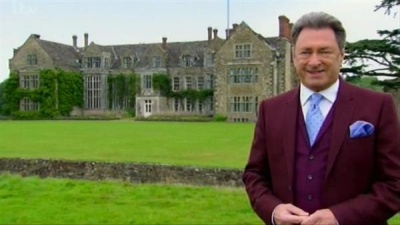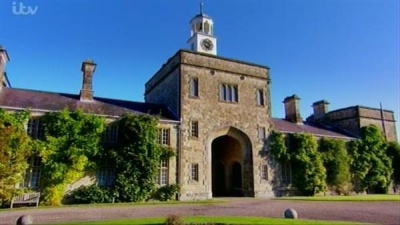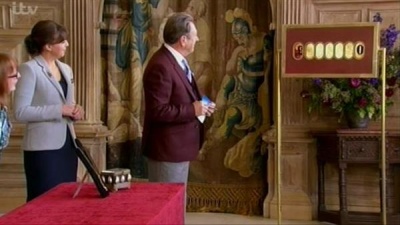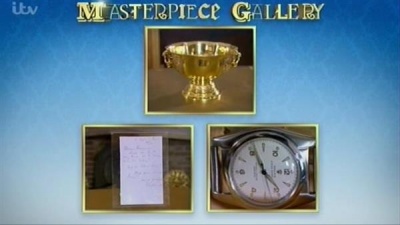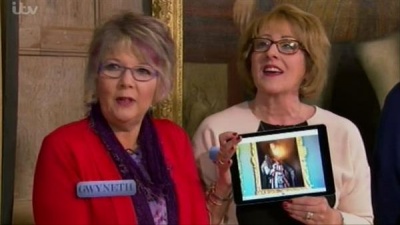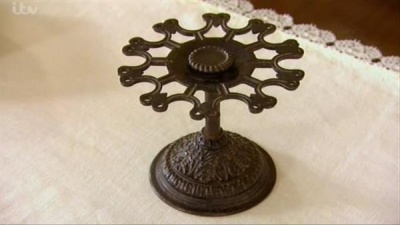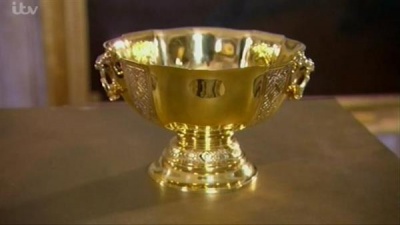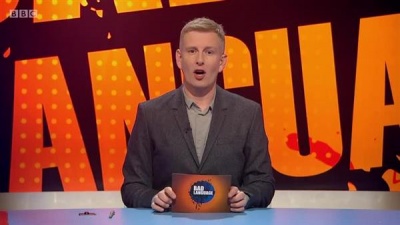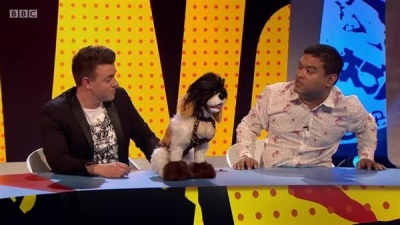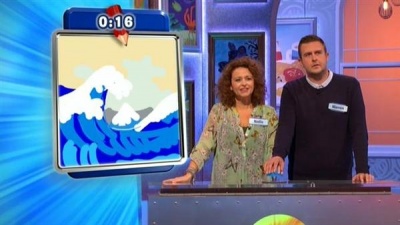Weaver's Week 2016-03-06
Last week | Weaver's Week Index | Next week
What better for 3pm than another antiques show?
Contents |
Masterpiece with Alan Titchmarsh
ITV, from 15 February
This column remembers Alan Titchmarsh as the daytime television gardener, or from the bizarre impressions on Run the Risk. Over the last while, Alan has swapped homely jumpers and sensible trousers for smarter suits. He's had a daytime chat show on ITV, presented documentaries about royalty, hosted Popstar to Operastar. In short, he's turned from a gardener into a comfortable figure for middle England.
Of course, some people will sneer at anything to do with middle England. We're having none of this: Titchmarsh has found a niche, he conjures a gentle village where people are civil to each other. Perhaps he offers a romantic notion of the countryside, detached from reality. Perhaps he's a bit northern for these southern softies. Perhaps critics are just unhappy that hard work has paid off. It's certain that Titchmarsh is very successful at what he does, and we're not going to criticise someone just for being successful.
Masterpiece is a show about antiques. There are lots of old things on the show, and we see one of them in the opening shot. It's Alan Titchmarsh standing in front of a stately home. A really old stately home, and we'll get a brief tour as the show goes on.
According to the rules of television, any antiques show needs an antiques expert, and Masterpiece uses Rachel Houston-Holland. She knows all the prices, and lots of background information. Alan knows what's going to happen, he devised the format.
On this show, the currency is "retail value", how much the item would sell for an antiques shop. This is different from the money on BBC antiques shows, which tend to use "hammer price" at auctions. And it's different again from the metric on Channel 4's shows like French Collection and Four Rooms, which use the price an antiques shop would pay for something. All of these are valid measures, they're consistent within each programme, but you can't compare so easily between shows.
Three pairs play each show, we meet them in the opening moments. Introductions are perfunctory, "this is Bill and Ben, they work in the gardens at Weedon." Before the show started, the pairs were invited to value a cheap item. The order of success determines the order of play in round one.
Valuation
On the table are nine items. All are collectable, some are more valuable than others. The teams have a few minutes to look at the items, discuss amongst themselves and with the camera.
Then the first team picks one of the items, and they're told how much it's worth. The show uses a count-up scoreboard, its soundtrack whirrs and clunks. The score increases in ten pounds, then in twenties, and fifties, and stops on its value. Perhaps the stop needs a bit more oomph, we kept missing the fact that it had stopped.
After this, the second team makes their pick, and finds the value. The same for the third team.
But back to the table of items for a moment. These are nine curious items, all of interest to collectors, and most have values in the hundreds of pounds. The items look like they're on a day trip from the BBC's For What It's Worth.
Masterpiece Gallery
The Masterpiece Gallery appears by magic in one of the rooms within the stately home. Each time, it contains three items. One item – and only one item – is worth at least £10,000. That's the "Masterpiece" of the show title. The others look more valuable than they are.
The winners of the prior round get to go first into the gallery. We hear a brief description of the item, and we see the winning team handle all three. Latex gloves, of course, this could be an expensive and delicate antique. After a couple of minutes, the team makes their choice, and explains it to Alan. Then the runners-up look at the two remaining items, and the losers are introduced to the item left for them.
We'll come back to the masterpiece collection at the end of the show.
For now, money talks: it's the first ad break. In the 3pm hour, ITV runs two very short breaks (it's so they can get in long breaks around Tipping Point and The Chase), so it's only a moment before we're back with Alan.
Stately Home Challenge
Round two is the challenge to stretch the teams' legs, as well as their brains. Each team is issued with a generic tablet. On the tablet, indications for two specific items in the house. To be precise, two specific items in a few rooms in the house. So we're going to see the teams go through these rooms, looking at various items, seeking the precise ones to meet the clues.
After only a few minutes, the search is over, and Alan explains what they were looking for. Have the teams managed to photograph the right objects? The clues are well balanced: one is much harder than the other, and both would confuse someone who only has a passing interest in antiques. With three teams and two clues, ties are likely, so speed is the tiebreak.
Why have they used tablets? It's so the teams can show their pictures in the game, and the pictures can be seen on screens at home. They've thought about the details on this show.
The result of this challenge tells who will go first into the Masterpiece Gallery. The elves have replaced the claimed antiques with three new ones, and again just one is worth £10,000 or more.
Distinctly Vintage
A stately home will have its grounds, or some stables, or a pagoda in the garden. In this round, each team is shown an item. It could be a car driving up, or they're taken to a garden feature. And the question: is this older or newer than the last item?
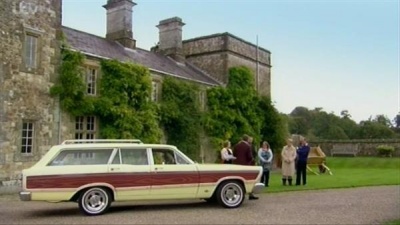 They must have been tempted to call this round "Play Your Cars Right". Good name, good name, far better than last week's.
They must have been tempted to call this round "Play Your Cars Right". Good name, good name, far better than last week's.
There's a further challenge: if the teams can get the exact age of their antique, they'll get an extra point.
Again, the round is over quickly. The tiebreak in this round is how wrong the year guess was, and if necessary to value the last of the expensive items. Then it's back to the Masterpiece Gallery. And then another quick commercial break.
Bamboozle
The final round is an antique of its own: Bamboozle! Here, Alan shows the players an array of obscure items, all used somewhere in or around the stately home. The team that finished last in Play Your Cars Right picks one of the items, and challenges the next team down to say what it was used for. Three options are available.
There's a point for the right answer, but if the team guesses wrongly, the point goes to the team who picked the item, because they've bamboozled the opposition. If they need a tiebreak, it's to give the age or value of one of the remaining items. After everyone's been challenged with an item, the best performance picks from the final Masterpiece Gallery.
Before the big reveal, there's a commercial break. A full-length commercial break.
The big reveal
And so we reach the reveal of the masterpieces. Each team has a pile of four items in front of them, and they hope to have the most Masterpieces. We start with the first pick from the first gallery, and find out its price. One hundred. Five hundred. One thousand. Fifteen hundred. Will the ticker tick round past £10,000?
We could see the ticker roll eight times in as many minutes. We will see it roll at least four times, likely more. In what has been a pacy show, this final segment tends to be repetitive, and it's the only part of the show that feels dragged out.
So we find that one team has more Masterpieces than any other: 2-1-1, or 3-1. The winning team takes home £1000. Everyone's had a grand day out at a stately home. When the show ends 2-2, the total value of the Masterpieces is used as a tiebreak. If there's something worth £30,000 in the game, that's almost enough to win on its own.
With nine different segments, the show has to keep moving. The pace is brisk without ever being too fast. That differentiates it from the pedestrian Countdown, and from the slow quizzes on BBC1. The show also has a high-quality soundtrack from Paul Farrer: upbeat, enthusiastic, and just a little lighter than we might expect.
By going at a decent pace, Masterpiece has had to discard some other things it could have done. If the show had been slower, we would have had more chance to appreciate the works. Gaze upon the artistry, recognise the fine art and craftsmanship. The show has a laser-like focus on price, on how much something will sell for.
And that brings us back to people sneering at Alan Titchmarsh. His show knows the price of everything, and the value of nothing. That's so not the done thing, very gauche. "One can take the man out of the working class..." We're not sure there's a defence against that reading. We're not sure there needs to be a defence, because a defence concedes that the prosecution has a point. Be honest: other than snobbery, what's wrong with an interest in money?
This column chooses to make judgements on what we see on screen, not on assumptions about "proper" behaviour. Masterpiece is an entertaining show, and we learn something from it. It's different from Countdown, and we prefer it over the false drama on For What It's Worth. Whether that's enough to bring the show back for a second series, we don't know.
Bad Language
BBC1 Northern Ireland, 22 January – 26 February
Every year, BBC Northern Ireland makes some home-grown comedy. Monumental – a series celebrating the best of Northern Irish talent – was too parochial to work outside the six counties. Bad Language has been made with an eye to the rest of the UK.
The basic idea is to poke fun at the language, to play with the words we do use and enquire after the ones we don't. The idea was first heard on a Northern Ireland – Scotland radio series in 2013. It's been simplified for television – we don't hear so much about dialect and slang words – but there's still a distinct Northern Irish feel to the show.
Patrick Kielty hosts, with resident captains Paul Sinha (from The Chase) and Susan Calman (from The Lie). That's Ulster hosting, with Asian-England and Scotland on the panel. They're joined by two other comedians, almost always people who flew into Belfast. So it's very much an outsider's view of language.
The radio show chopped along with six or seven rounds. On the telly, that's cut to three rounds, the same ideas on each edition. For the first, the players suggest entries for The Banned List, words or phrases that might profitably be taken out of use.
The inevitable "who said that" round fits in the middle. It's a cliché, and Bad Language quietly acknowledges that it's a cliché by getting the round over as quickly as possible.
There's more time for the final round, where the panellists pool their brains to sell a difficult topic. One panel is given a bizarre item to describe, the other side writes down words and phrases they expect to hear. It's a fine piece of improvisation and inventiveness. Each round is decided by Patrick, based on what he hears from the studio audience.
By bringing people in from all parts of the country, we're able to hear about little cultural differences. The argot of Glasgow, the words they use in Brighton, contributions from folk like Marcus Brigstocke, Des Clarke, and the antipodean Jarred Christmas. But don't watch Bad Language for great linguistic insights, it aims to be a comedy show.
Does it succeed? Just about: we passed the six laughs test in the closing minutes of two sample episodes. Could it work as a show for the entire UK? Very easily: the programmes could slot into BBC2 right now.
Countdown update
After the scoring excesses of the Championship of Champions, Countdown has returned to more normal performances. We viewers could play along with some of the contestants.
Tim Down was the carry-over champion, and he completed eight wins. A total of 717 points is very low by octochamp standards, but all he has to do is get into the quarter-finals and practice. Michael Lees won one game, and was unlucky to come across David Edgar on a good day – David turned out to be a streaky player, and notched up four wins.
Jack Creswell and David Armstrong made solid records, and three wins each. Jack had the misfortune of a show where the maximum score was 111, the lowest maximum since May 2010. David ran into Paul Erdunast, by far the best player we've seen this series. Where other players might get six maximum scores in a show, Paul regularly ran ten, eleven, twelve maximum rounds. Consistency is the hallmark of a champion; Paul's total of 925 is the highest heats total since 2014, and included six scores of 111 or more.
Alexander Assim took over the empty champions' chair, then surrendered it to Paul Craib. In three games, Paul has looked good, but feels beatable. We wouldn't be surprised if he wins eight, or if he's defeated soon.
Horse racing begins to disrupt the Countdown experience after next week, and we understand the grand final is scheduled for Monday 27 June.
This Week and Next
We're sorry to hear that Victory Television is to close. The production company, a division of Sony, made some very decent game shows. The Exit List for ITV. The Fanatics for satellite telly. Draw It! and Benchmark for Channel 4. Win Your Wish List for BBC1. They brought down the curtain on Who Wants to be a Millionaire, and made the oh-so-promising Five Minutes to a Fortune. Not a clunker in the canon, even Benchmark had its merits, but only Win Your Wish List has secured a second series. There was a lot of talent in Victory, we wish the best to all concerned.
How they made the Australian radio contest SA-FM Fugitive. Known in the UK as the Real Radio Renegade, or the BRMB Shadow. Or, back in 1927, as Lobby Lud of the Westminster Gazette. (See also: the Week of 28 August 2011.)
University Challenge returned to the bottom half of the group phase, with the elimination match. York beat St Catharine's Cambridge by 180-115. Catz were never in it, the score doesn't disgrace them.
Highlights included a suggestion that Mr. Joly de Lotbiniere has a family coat of arms. And we were pleased to see a shopping list bonus question: name seven of the 2004 accession capitals for fifteen points, fewer for less. They tried a few of these lists in the first shows of the revival, but we haven't heard one in at least a decade. The Johnny Mercer fan club was not impressed that the producers forgot his contribution to "Moon river" (the lyric).
No Mastermind this week, taken off for cycling.
BARB ratings in the week to 21 February.
- Call the Midwife is still the most-viewed show, but slips to 9.65m viewers. The Great Sport Relief Bake Off becomes the top game, with 7.1m viewers.
- BBC The Voice of Holland of UK was dented – the singing show had 6.55m, Saturday Night Takeaway scored 6.3m on ITV-SD and a further 1.8m on ITV-HD.
- A tie between BBC2 and Channel 4's top games, The Great Interior Design Challenge and The Jump both interested 1.88m people. Let's Play Darts for Comic Relief returned to 1.65m.
- Take Me Out The Gossip continued to lead on digital channels, with 915,000 this week. A League of Their Own brought 645,000 to The Satellite Channel.
- 530,000 for Come Dine with Me on More4 is over half the viewing figure for new episodes on Channel 4.
This week, Penn and Teller stage Fool Us in Vegas, and to Channel 5 (Sun). We find the winners of Got What It Takes? (CBBC, Wed) and The Jump (C4, Sun), and there's a one-off panel show Jonathan's Six Nations Quiz (BBC1 Wales, Wed). The cast of The Hungry Games appear on Saturday Night Takeaway.
Which reminds us, it's Puzzled Pint on Tuesday. London's event has been going since 2013, joined this month by a meeting in Manchester. Puzzledpint.com has the location puzzle, and a little hint from the Week: they're not seeking "ether".
Photo credits: Spun Gold, Teletext, Green Inc, Victory Television.
To have Weaver's Week emailed to you on publication day, receive our exclusive TV roundup of the game shows in the week ahead, and chat to other ukgameshows.com readers, sign up to our Yahoo! Group.


